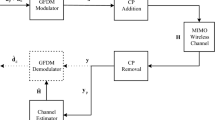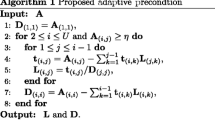Abstract
This paper discusses a framework for algorithm-architecture synergy for (1) performance evaluation and (2) FPGA implementation complexity analysis of linear massive MIMO detection techniques. Three low complexity implementation techniques of the zero-forcing (ZF) based linear detection are evaluated, namely, Neumann series expansion (NSE), Gauss–Seidel (GS) and a proposed recursive Gram matrix inversion update (RGMIU) techniques. The performance analysis framework is based on software-defined radio platform. By extrapolating the real data measured average error vector magnitude versus a number of served single-antenna user terminals, GS and RGMIU are showing no performance degradation with respect to ZF with direct matrix inversion. It is shown that under high load regime NSE and GS require more processing iterations at the expense of increased processing latency. We, therefore, consider a unified approach for field-programmable gate array based implementation complexity analysis and discuss the required baseband processing resources for real-time transmission. Due to the wide differences of NSE, GS and RGMIU in terms of performance, processing complexity and latency, practical deployment and real-time implementation insights are derived.








Similar content being viewed by others
Notes
Note that these limits are also establish by 3GPP for LTE transmitter’s modulation accuracy performance.
We also expect early deployments will be limited to less than 64 antenna elements for the sake of size and energy efficiency..
In fact, the LTE uplink uses SC-FDMA whereas the downlink adopts FDMA. This is mainly due to the fact that handsets can not afford to support a high peak to average power ratio (PAPR) inherent in FDMA. Our reference SDR design uses FDMA on both links to keep it symmetrical and ease waveform development especially in assigning uplink pilots to the users. Since the processing is done after IFFT, we do not expect noticeable impact unless the radio at the UE side is running at high output power which would make PAPR affect the uplink performance. Particularly, the performance would be decreased in the UL for UEs operating at high power, e.g. signaling at the cell margin. We (coarse) tuned the output power so that the UEs operate in a safe non-saturated region especially that the set-up is constrained to line-of-sight.
For instance, one can alter the transceiver’s local oscillator phase noise by tuning the charge-bump current.
Over the air synchronization and coarse frequency and sampling rate offset compensation is consider for future work.
(24 bits/subcarrier × 1200 subcarrier/symbol × 5 symbols/sub-frame)/(1 ms/sub-frame).
(6 bits/subcarrier × 1200 subcarriers/symbol × 5 symbols)/1 ms.
This expression is accurate if the number of UTs \( K \cong 2^{N} \) where \( N \) is a positive integer.
The BRAM resources are not shown here due to their low use ratio.
Out of the scope of this work, it is interesting to investigate how one can leverage on weights interpolation instead of computing them on every subcarrier.
576 DSP48s are required for 12 × 12 DWMC core.
The non-pipelined DSP48s maximum frequency is 260 MHz and 335 MHz for low and high speed grade Xilinx’s Kintex UltraScale XCKU115 FPGA.
For the sake of clarification; based on the DWMC core, data and processing flow dependencies determine the overall latency which explains why NSE (order 4) has lower latency compared to ZF (based on Cholesky decomposition).
References
Björnson, E., Sanguinetti, L., Wymeersch, H., Hoydis, J., & Marzetta, T. L. (2019). Massive MIMO is a reality—What is next? Five promising research directions for antenna arrays. Digital Signal Processing,94, 3–20.
Björnson, E. (2018). A look at an LTE-TDD Massive MIMO product. Retrieved November 17, 2019, from http://ma-mimo.ellintech.se/2018/08/27/.
von Butovitsch, P., Astely, D., Friberg, C., Furuskär, A., Göransson, B., Hogan, B., et al. (2018). Advanced antenna systems for 5G networks. Ericsson white paper. Retrieved November 17, 2019, from https://www.ericsson.com/4a8a87/assets/local/publications/white-papers/10201407_wp_advanced_antenna_system_nov18_181115.pdf.
Qu, Y., Lozano, A., & Gatherer, A. (2019). Nine communications technology trends for 2019. Communication society technology news. Retrieved November 17, 2019, from https://www.comsoc.org/publications/ctn/nine-communications-technology-trends-2019.
Shepard, C., Yu, H., Anand, N. et al. (2012). Argos: practical many-antenna base stations. In Annual International Conference on Mobile Computing and Networking, New York (pp. 53–64).
Malkowsky, S., et al. (2017). The world’s first real-time testbed for massive MIMO: design, implementation, and validation. IEEE Access,5, 9073–9088.
(2015). TitanMIMO-6: The sub-6 GHz 5G massive MIMO testbed. Product sheet. Nutaq Innovation. Retrieved November 17, 2019, https://www.nutaq.com/wp-content/uploads/2015/07/TitanMIMO6_09_16_2014_Final.pdf.
Ngo, H.Q. (2015). Massive MIMO: Fundamentals and system designs, Ph.D. Thesis, Linköping University Electronic Press.
Wu, M., Yin, B., Wang, G., Dick, C., Cavallaro, J. R., & Studer, C. (2014). Large-scale MIMO detection for 3GPP LTE: Algorithms and FPGA implementations. IEEE Journal of Selected Topics in Signal Processing,8(5), 916–929.
Wu, Z., Zhang, C., Xue, Y., Xu, S., & You, Z. (2016). Efficient architecture for soft-output massive MIMO detection with Gauss–Seidel method. In IEEE International Symposium on Circuits and Systems, Montreal (pp. 1886–1889).
Wu, M., Dick, C., Cavallaro, J. R., & Studer, C. (2016). High-throughput data detection for massive MU-MIMO-OFDM using coordinate descent. IEEE Transactions on Circuits and Systems I: Regular Papers,63(12), 2357–2367.
Jeon, C., Li, K., Cavallaro, J. R., & Studer, C. (2019). Decentralized equalization with feedforward architectures for massive MU-MIMO. IEEE Transactions on Signal Processing,67(17), 4418–4432.
Ahmed Ouameur, M. & Massicotte, D. (2019). Efficient distributed processing for large scale MIMO detection. European Signal Processing Conference (Eusipco), A Coruna, Spain, 2–6 Sept., 2019 (pp. 1–4).
Ahmed Ouameur, M., & Massicotte, D. (2019). Deep autoencoder for interconnect’s bandwidth relaxation in large scale MIMO-OFDM processing. Retrieved November 17, 2019, https://arxiv.org/abs/1907.12613
Rosário, F., Monteiro, F. A., & Rodrigues, A. (2016). Fast matrix inversion updates for massive MIMO detection and precoding. IEEE Signal Processing Letters,23(1), 75–79.
Khan, M.E., (2008). Updating inverse of a matrix when a column is added/removed. Technical Report, Computer Science of University of British Columbia, 3 pages.
Björnson, E., Bengtsson, M., & Ottersten, B. (2014). Optimal multiuser transmit beamforming: A difficult problem with a simple solution structure. IEEE Signal Processing Magazine,31(4), 142–148.
Zhang, R., Ai, B., Yang, L., Song, H., & Li, Z. Q. (2014). A precoding and detection scheme for OFDM based wireless communication system in high-speed environment. IEEE Transactions on Consumer Electronics,60(4), 558–566.
Björnson, E., Hoydis, J., Kountouris, M., & Debbah, M. (2014). Massive MIMO systems with non-ideal hardware: Energy efficiency, estimation, and capacity limits. IEEE Transactions on Information Theory,60(11), 7112–7139.
Mi, D., Dianati, M., Zhang, L., Muhaidat, S., & Tafazolli, R. (2017). Massive MIMO performance with imperfect channel reciprocity and channel estimation error. IEEE Transactions on Communications,65(9), 3734–3749.
Björnson, E., Larsson, E. G., & Marzetta, T. L. (2016). Massive MIMO: Ten myths and one critical question. IEEE Communications Magazine,54(2), 114–123.
Shafik, R. A., Rahman, M. S., & Islam, A. R., (2006). On the extended relationships among EVM, BER and SNR as performance metrics. In International Conference on Electrical and Computer Engineering, Dhaka (pp. 408–411).
Yang, X., et al. (2017). Design and implementation of a TDD-based 128-antenna massive MIMO prototype system. China Communications,14(12), 162–187.
Harris, P., et al. (2016). LOS throughput measurements in real-time with a 128-antenna massive MIMO testbed. In IEEE Global Communications Conference, Washington, DC (pp. 1–7).
Ahmed-Ouameur, M., Massicotte, D., & Zhu, W., (2015). Carrier frequency and sampling rate offsets effect on sub 6 GHz Massive MIMO. In Nordic Circuits and Systems Conference (NORCAS), Oslo (pp. 1–4).
Ma, X., Gao, Q., Wang, J., Marojevic, V., & Reed, J. H. (2017). Dynamic sounding for multi-user MIMO in wireless LANs. IEEE Transactions on Consumer Electronics,63(2), 135–144.
(2015). 2nd Gen. PicoSDR, 2nd generation 70–6000 MHz SDR development platform. Nutaq Innovation. Retrieved November 17, 2019, from https://www.nutaq.com/picosdr8x8.
(2019). Xilinx Zynq-7000 All Programmable SoC ZC706 Evaluation Kit, Xilinx. Retrieved November 17, 2019, from https://www.xilinx.com/products/boards-and-kits/ek-z7-zc706-g.html.
Björnson, E., Matthaiou, M., & Debbah, M. (2015). Massive MIMO with non-ideal arbitrary arrays: Hardware scaling laws and circuit-aware design. IEEE Transactions on Wireless Communications,14(8), 4353–4368.
(2015). Nutaq OFDM Reference Design: FPGA based SISO/MIMO PHY transceiver. Nutaq Innovation. Retrieved November 17, 2019, from https://www.nutaq.com/sites/default/files/ofdm-wireless-lowres.pdf.
(2015). IMT vision—Framework and overall objectives of the future development of IMT for 2020 and beyond. ITU-R Working Party WP 5D: Draft New Recommendation. Doc. R12-SG05-C-0199. Retrieved November 17, 2019, from https://www.itu.int/dms_pubrec/itu-r/rec/m/R-REC-M.2083-0-201509-I!!PDF-E.pdf.
Acknowledgements
This work was supported in part by NUTAQ innovation and the Natural Sciences and Engineering Research Council of Canada.
Author information
Authors and Affiliations
Corresponding author
Additional information
Publisher's Note
Springer Nature remains neutral with regard to jurisdictional claims in published maps and institutional affiliations.
Appendix
Appendix
To make the paper self-contained this appendix derives the matrix inversion of a large \( K \times K \) matrix of the form \( {\mathbf{H}}^{H} {\mathbf{H}} \). We propose to apply the matrix inversion update lemma when a new column is added [16]. Assume we have the inverse of a \( \left( {K - 1} \right) \times \left( {K - 1} \right) \) matrix \( {\varvec{\Delta}}_{K - 1}^{ - 1} = {\mathbf{H}}_{1:K - 1}^{H} {\mathbf{H}}_{1:K - 1}^{{}} \) (note that we have adopted the Matlab index notation \( 1:K - 1 \) in \( {\mathbf{H}}_{1:K - 1}^{{}} \) to designate columns 1 to \( K - 1 \) of \( {\mathbf{H}} \)). Therefore, the inverse of a \( K \times K \) matrix \( {\varvec{\Delta}}_{K}^{ - 1} = {\mathbf{H}}_{1:K}^{H} {\mathbf{H}}_{1:K}^{{}} \) can be computed as follow
where \( c = \frac{1}{{\left( {{\mathbf{H}}_{K:K}^{H} {\mathbf{H}}_{K:K}^{{}} } \right) - \left( {{\mathbf{H}}_{1:K - 1}^{H} {\mathbf{H}}_{K:K}^{{}} } \right)^{H} {\varvec{\Delta}}_{K - 1}^{{}} \left( {{\mathbf{H}}_{1:K - 1}^{H} {\mathbf{H}}_{K:K}^{{}} } \right)}} \) and \( {\varvec{\Gamma}} = {\varvec{\Delta}}_{K - 1}^{{}} + c{\kern 1pt} {\varvec{\Delta}}_{K - 1}^{{}} \left( {{\mathbf{H}}_{K:K}^{H} {\mathbf{H}}_{1:K - 1}^{{}} } \right)^{H} \left( {{\mathbf{H}}_{K:K}^{H} {\mathbf{H}}_{1:K - 1}^{{}} } \right){\varvec{\Delta}}_{K - 1}^{H} \).
If we set \( {\mathbf{z}} \triangleq {\mathbf{H}}_{K:K}^{{}} \), \( {\mathbf{y}}_{1} \triangleq {\mathbf{H}}_{1:K - 1}^{H} {\mathbf{z}} \),\( {\mathbf{y}}_{2} \triangleq {\varvec{\Delta}}_{K - 1}^{{}} {\mathbf{y}}_{1} \), and \( {\mathbf{y}}_{3} \triangleq c{\kern 1pt} {\kern 1pt} {\mathbf{y}}_{2} \) then \( c = {1 \mathord{\left/ {\vphantom {1 {\left( {{\mathbf{z}}^{H} {\mathbf{z}} - {\mathbf{y}}_{1}^{H} {\mathbf{y}}_{2}^{{}} } \right)}}} \right. \kern-0pt} {\left( {{\mathbf{z}}^{H} {\mathbf{z}} - {\mathbf{y}}_{1}^{H} {\mathbf{y}}_{2}^{{}} } \right)}} \) and \( {\varvec{\Gamma}} = {\varvec{\Delta}}_{K - 1}^{{}} + c{\kern 1pt} {\mathbf{y}}_{2}^{{}} {\mathbf{y}}_{2}^{H} \).
Applying Eq. (6) successively from the second column all the way to the last column \( K \), the algorithm, dubbed recursive gram matrix inversion update (RGMIU), is outlined in Table 1.
Rights and permissions
About this article
Cite this article
Ahmed Ouameur, M., Massicotte, D., Akhtar, A.M. et al. Performance evaluation and implementation complexity analysis framework for ZF based linear massive MIMO detection. Wireless Netw 26, 4079–4093 (2020). https://doi.org/10.1007/s11276-020-02318-y
Published:
Issue Date:
DOI: https://doi.org/10.1007/s11276-020-02318-y




